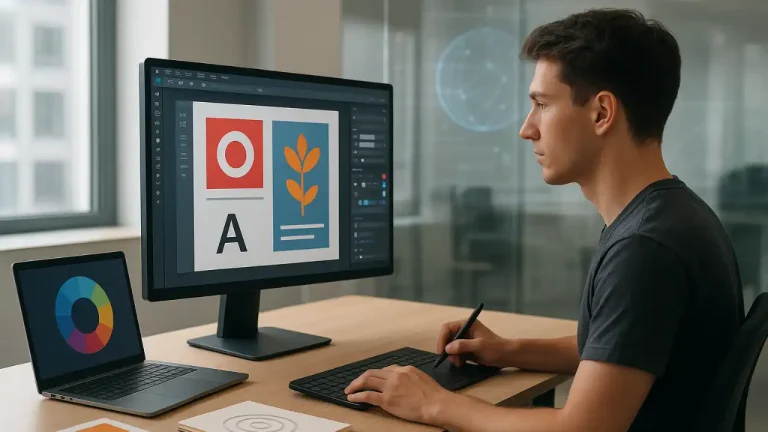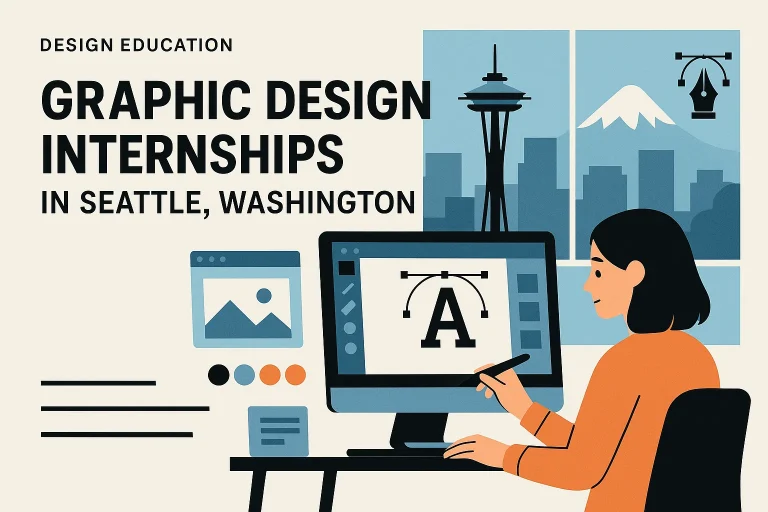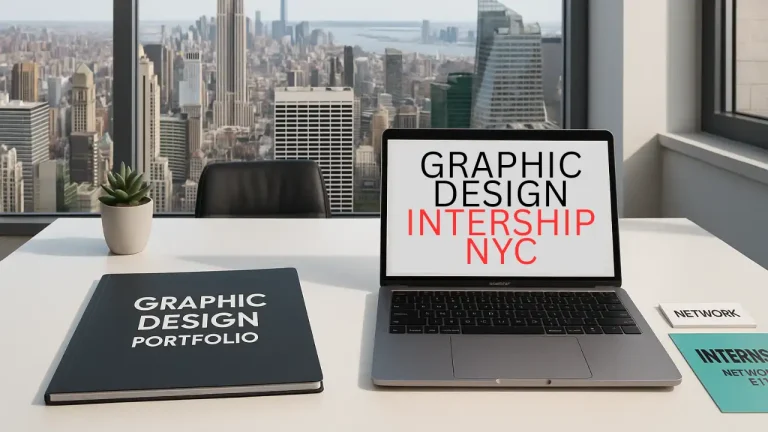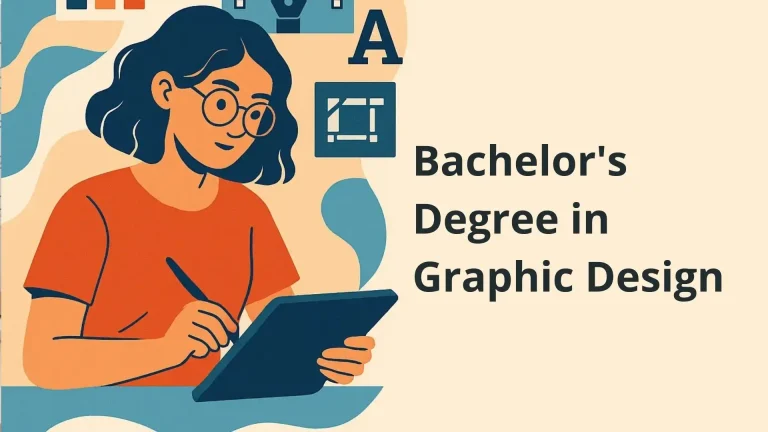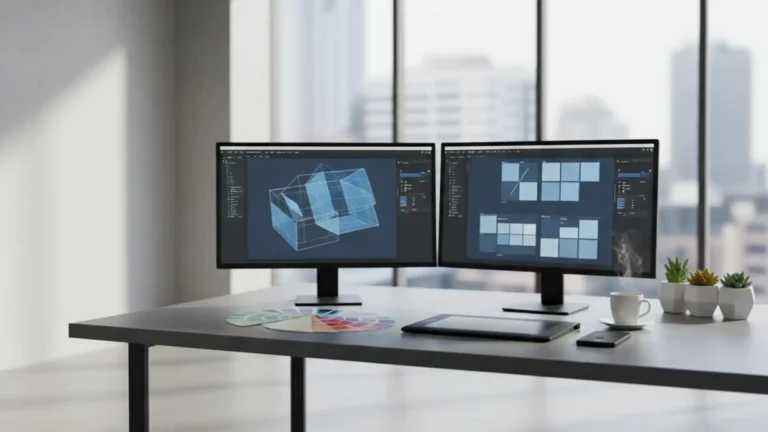Graphic Designer Intern Jobs
Table of Contents
Breaking into the design world can feel overwhelming, especially when every job posting seems to require years of experience. But here’s the secret: graphic designer intern jobs are your golden ticket to launching a successful creative career. These positions offer the perfect stepping stone to gain real-world experience, build professional connections, and develop the skills that employers actually want.
Whether you’re a recent graduate, career changer, or creative professional looking to specialize, landing the right internship can transform your future. The competition might seem fierce, but with the right strategy and preparation, you can stand out from the crowd and secure that dream position.
In this comprehensive guide, we’ll walk you through everything you need to know about finding and securing graphic designer intern jobs. From understanding different types of opportunities to crafting killer applications, we’ve got you covered. Let’s dive in and turn your creative passion into a thriving career.
Understanding Graphic Design Internships
What is a Graphic Design Internship?
A graphic design internship is a temporary work experience program where aspiring designers gain hands-on training while contributing to real projects. Unlike traditional classroom learning, these positions immerse you in the day-to-day operations of design teams, agencies, or creative departments.
During your internship, you’ll work alongside experienced designers, creative directors, and other professionals who can guide your development. You’ll tackle actual client projects, learn industry-standard workflows, and discover how design fits into broader business objectives.
Most graphic artist intern positions last between 10-16 weeks, though some companies offer year-long programs or part-time arrangements that work around academic schedules. The key is finding opportunities that align with your career goals and learning objectives.
Types of Graphic Design Internships
Paid vs. Unpaid Internships
Paid internships are becoming increasingly common as companies recognize the value interns bring to their teams. These positions typically offer hourly wages ranging from $15-25 per hour, depending on location and company size. Paid opportunities often attract higher-quality candidates and tend to provide more substantial learning experiences.
Unpaid internships still exist, particularly at smaller agencies, non-profits, and startups. While these positions don’t offer monetary compensation, they might provide other benefits like academic credit, flexible schedules, or unique project opportunities. Always ensure unpaid positions comply with labor laws and offer genuine educational value.
Remote vs. In-Office Opportunities

The rise of remote work has revolutionized internships for graphic design. Remote positions offer flexibility and access to companies regardless of geographic location. You’ll typically use cloud-based design tools, participate in virtual meetings, and collaborate through digital platforms.
In-office internships provide direct mentorship, face-to-face collaboration, and immersion in company culture. You’ll observe professional interactions, participate in brainstorming sessions, and potentially access specialized equipment or software.
Many companies now offer hybrid arrangements, combining remote flexibility with periodic office visits for key meetings or collaborative sessions.
Full-time vs. Part-time Positions
Full-time internships typically require 35-40 hours per week and offer deeper project involvement. These positions work well for gap year students, recent graduates, or those fully committed to launching their design careers.
Part-time internships, usually 15-25 hours weekly, accommodate students balancing coursework with professional experience. These arrangements often extend longer than full-time programs, providing sustained learning opportunities.
Industry-Specific Internships
Different industries offer unique design challenges and specialization opportunities:
Tech companies focus on user interface design, mobile applications, and digital products. You’ll learn about user experience principles, responsive design, and tech industry workflows.
Fashion brands emphasize visual merchandising, catalog design, and brand identity work. These positions often involve trend research, photo styling, and seasonal campaign development.
Publishing houses concentrate on editorial design, book layouts, and digital publishing platforms. You’ll master typography, grid systems, and content organization principles.
Marketing agencies provide exposure to diverse clients and campaign development. You’ll work on branding projects, advertising materials, and multi-channel marketing campaigns.
Benefits of Pursuing a Graphic Design Internship
Real-world Experience and Skill Development
Internships bridge the gap between academic theory and professional practice. You’ll learn industry-standard workflows, client communication strategies, and project management techniques that textbooks can’t teach.
Working on actual client projects with real deadlines develops your problem-solving abilities and time management skills. You’ll discover how to balance creative vision with practical constraints, budgets, and client expectations.
Portfolio Enhancement Opportunities
Professional projects carry more weight than academic assignments when applying for jobs. Internships provide access to high-quality work that demonstrates your ability to contribute to professional teams and meet industry standards.
You’ll also learn how to present your work professionally, understand client feedback processes, and develop case studies that showcase your design thinking and problem-solving approach.
Professional Networking and Mentorship
Building relationships within the industry is crucial for long-term career success. Internships connect you with experienced professionals who can provide guidance, recommendations, and future job opportunities.
Many successful designers credit their internship mentors with shaping their career trajectories. These relationships often continue long after the internship ends, providing ongoing support and advice.
Potential Pathway to Full-time Employment
Many companies use internship programs as extended interview processes for future full-time hires. Strong intern performance often leads to job offers, either immediately following the program or when positions become available.
Even if your internship company doesn’t have immediate openings, the experience and connections you’ve gained will strengthen applications elsewhere.
Essential Skills and Qualifications
Technical Skills Required
Adobe Creative Suite Proficiency

Mastering Adobe’s design software is non-negotiable for most graphic designer intern jobs. Photoshop skills are essential for image editing, photo manipulation, and digital artwork creation. You should understand layers, masks, adjustment tools, and basic retouching techniques.
Illustrator expertise enables vector graphics creation, logo design, and scalable artwork development. Focus on pen tool mastery, shape manipulation, and typography tools.
InDesign knowledge is crucial for layout-heavy projects like brochures, magazines, and multi-page documents. Learn about grids, master pages, and print preparation workflows.
Typography and Layout Principles
Understanding typography goes beyond choosing attractive fonts. You need to grasp hierarchy, readability, spacing, and how type choices affect message perception. Study classic typeface classifications and learn to pair fonts effectively.
Layout principles involve organizing visual elements to guide viewer attention and communicate messages clearly. Master concepts like balance, contrast, alignment, and white space utilization.
Color Theory and Composition
Color theory knowledge helps you create harmonious palettes and evoke specific emotions through color choices. Understand warm and cool colors, complementary relationships, and cultural color associations.
Composition skills involve arranging elements to create visually appealing and effective designs. Study rule of thirds, golden ratio, and visual weight distribution.
Digital Design Fundamentals
Modern design work requires understanding digital formats, resolution requirements, and optimization techniques. Learn about RGB vs. CMYK color modes, file format selection, and compression methods.
Web design basics are increasingly important, even for print-focused positions. Understand responsive design principles, web-safe fonts, and basic HTML/CSS concepts.
Web Design Basics and UI/UX Understanding
User interface design skills are valuable across industries as companies digitize their operations. Learn about user-centered design principles, wireframing, and prototyping tools.
Basic UX understanding helps you create designs that function well and meet user needs, not just look attractive. Study user journey mapping, usability principles, and accessibility guidelines.
Soft Skills That Matter
Communication and Collaboration Abilities
Design is rarely a solo endeavor. You’ll need to articulate design decisions, accept feedback gracefully, and collaborate with diverse team members. Practice explaining your creative choices in business terms that non-designers understand.
Active listening skills help you understand client needs and team requirements. Learn to ask clarifying questions and summarize feedback to ensure understanding.
Time Management and Deadline Adherence
Design projects operate on tight deadlines, often with multiple projects running simultaneously. Develop systems for tracking deadlines, estimating task duration, and prioritizing competing demands.
Learn to balance perfectionism with practical time constraints. Sometimes good work delivered on time beats perfect work delivered late.
Creative Problem-Solving
Clients present challenges that require creative solutions within specific parameters. Develop your ability to generate multiple concepts quickly and evaluate solutions objectively.
Practice constraint-based creativity, where limitations spark innovation rather than stifle it. Some of the best design work emerges from challenging requirements.
Adaptability and Willingness to Learn
The design industry evolves rapidly with new tools, trends, and technologies emerging constantly. Cultivate curiosity and embrace continuous learning as career necessities.
Stay flexible when projects change direction or new requirements emerge. Adaptability demonstrates professionalism and increases your value to employers.
Attention to Detail
Small details can make or break design success. Develop keen eyes for typography errors, alignment issues, and color inconsistencies. Professional work requires meticulous attention to every element.
Create personal quality control checklists to catch common errors before submitting work for review.
Educational Background and Portfolio Requirements
Degree Requirements and Alternatives
While many positions prefer candidates with design degrees, alternative paths exist for talented individuals. Graphic design, visual communications, and fine arts degrees provide solid foundations, but some employers prioritize portfolio quality over formal education.
Design bootcamps, online courses, and self-directed learning can supplement or replace traditional education. Focus on building skills and creating compelling work regardless of your educational background.
Portfolio Essentials and Presentation Tips
Your portfolio is your most important job application tool. Include 10-15 diverse projects that demonstrate range and skill progression. Show process work alongside final designs to illustrate your thinking approach.
Quality trumps quantity every time. Better to present fewer excellent pieces than many mediocre ones. Each project should serve a specific purpose in demonstrating your capabilities.
Organize your portfolio logically with clear project descriptions, your role explanation, and results achieved when possible. Make it easy for viewers to understand your contribution to team projects.
Online Presence and Personal Branding
Professional online presence extends beyond portfolio websites. LinkedIn profiles should highlight your skills, experience, and career objectives. Join design groups and share thoughtful content related to your interests.
Instagram and Behance profiles can showcase your personality and creative interests beyond client work. Personal projects, sketches, and behind-the-scenes content humanize your professional brand.
Maintain consistency across all platforms with professional headshots, cohesive bio information, and current contact details.
Where to Find Graphic Designer Intern Jobs
Top Job Boards and Websites
Indeed, LinkedIn, and Glassdoor Opportunities
Major job platforms host thousands of graphic design internships nyc and opportunities in other major markets. LinkedIn’s extensive filtering options help you narrow searches by location, company size, and industry focus.
Set up job alerts with relevant keywords to receive notifications when new positions post. Customize alerts for different search criteria to cast a wide net while maintaining relevance.
Glassdoor provides valuable insight into company culture, salary ranges, and interview experiences from former interns. Research potential employers thoroughly before applying.
Creative-Specific Platforms
Behance and Dribbble aren’t just portfolio platforms—they also host job boards focused specifically on creative positions. These platforms tend to attract companies that truly value design and understand creative workflows.
AIGA’s job board features positions from companies committed to design excellence and professional development. Many postings emphasize learning opportunities and mentorship components.
AngelList specializes in startup opportunities where interns often gain broader experience and increased responsibility. Startup environments can provide accelerated learning but may offer less structure than established companies.
Company Career Pages
Many companies post internship opportunities exclusively on their websites before listing elsewhere. Identify target companies and check their career pages regularly for new postings.
Subscribe to company newsletters or follow social media accounts to stay informed about upcoming internship cycles and application deadlines.
Internship-Focused Websites
InternMatch, WayUp, and Handshake specialize in connecting students and recent graduates with internship opportunities. These platforms often feature positions specifically designed for emerging talent.
University career centers maintain relationships with companies seeking interns and may have access to exclusive opportunities not advertised publicly.
Company Types and Industries
Design Agencies and Studios
Design agencies offer immersive creative environments where you’ll work with diverse clients across various industries. These positions typically provide excellent mentorship and exposure to high-level creative work.
Agency culture tends to be fast-paced and deadline-driven, providing realistic preparation for professional design careers. You’ll likely work on multiple projects simultaneously and gain experience with different design challenges.
Corporate In-House Design Teams
Large corporations maintain internal design teams that handle branding, marketing materials, and digital assets. These positions offer stability, structured learning programs, and insight into how design supports business objectives.
Corporate internships often provide access to advanced technology, comprehensive training programs, and clear advancement pathways. The work might be less varied than agency positions but offers deeper industry expertise.
Tech Companies and Startups
Technology companies increasingly recognize design’s importance in product success, creating numerous opportunities for graphic artist intern positions. You’ll likely work on user interfaces, marketing materials, and brand development.
Startup environments offer unique learning opportunities with increased responsibility and exposure to multiple business areas. However, these positions may offer less structure and mentorship than established companies.
Non-Profit Organizations
Non-profit internships provide meaningful work experience while supporting causes you care about. These positions often involve diverse projects from fundraising materials to awareness campaigns.
While non-profits may offer limited compensation, they often provide flexibility, mission-driven work, and opportunities to make genuine social impact through design.
Publishing and Media Companies
Publishing internships focus on editorial design, digital content creation, and brand consistency across multiple platforms. You’ll learn about content-driven design and audience-specific communication strategies.
Media companies offer exposure to fast-paced news cycles, social media content creation, and multimedia storytelling techniques.
Marketing and Advertising Firms
Marketing internships provide broad exposure to campaign development, brand strategy, and multi-channel design execution. You’ll learn how design supports marketing objectives and drives business results.
These positions often involve collaboration with copywriters, strategists, and account managers, providing insight into integrated marketing approaches.
Geographic Considerations
Major Design Hubs and Metropolitan Areas
Graphic design internships nyc offer unparalleled opportunities in fashion, publishing, advertising, and corporate design. The city’s creative density provides networking opportunities and cultural inspiration.
Los Angeles focuses heavily on entertainment industry design, including film marketing, music industry graphics, and celebrity branding work.
San Francisco and Silicon Valley emphasize technology company opportunities with strong user experience and digital design components.
Chicago, Boston, and other major cities offer diverse opportunities across industries with potentially lower competition than coastal markets.
Remote Work Opportunities
Graphic design internships remote positions have expanded significantly, providing access to companies regardless of location. Remote internships require strong self-motivation and communication skills but offer unmatched flexibility.
Ensure remote positions provide adequate mentorship and feedback mechanisms. Virtual check-ins, collaborative tools, and structured learning components are essential for successful remote experiences.
International Internship Programs
International internships provide cultural immersion alongside professional development. Programs in Europe, Asia, and other regions offer unique design perspectives and global portfolio pieces.
Consider visa requirements, language barriers, and cultural differences when evaluating international opportunities. These experiences can significantly differentiate your background in competitive job markets.
Application Strategy and Process
Crafting an Outstanding Application
Resume Optimization for Design Roles
Design resumes should balance visual appeal with professional content. Clean, well-organized layouts demonstrate design sensibility without overwhelming the content.
Highlight relevant coursework, software skills, and any design-related experience, including personal projects and freelance work. Quantify achievements when possible and use action verbs to describe accomplishments.
Tailor your resume for each application, emphasizing skills and experiences most relevant to the specific position and company.
Cover Letter Personalization Techniques
Generic cover letters are immediately recognizable and rarely effective. Research the company thoroughly and reference specific projects, values, or recent news in your letter.
Explain why you’re interested in that particular company and role, not just any internship opportunity. Connect your background and goals to their specific needs and culture.
Keep cover letters concise but compelling, focusing on what you can contribute rather than what you hope to gain.
Portfolio Curation and Presentation
Curate your portfolio specifically for each application, emphasizing work most relevant to the company’s industry and style. Quality and relevance matter more than quantity.
Include process work that demonstrates your thinking approach, research methods, and iteration strategies. Employers want to understand how you approach problems, not just see final results.
Provide context for each project with clear descriptions of the challenge, your approach, and results achieved. Make it easy for reviewers to understand your role in collaborative projects.
Online Portfolio Best Practices
Ensure your online portfolio loads quickly, displays properly on mobile devices, and includes current contact information. Broken links or outdated content reflect poorly on your attention to detail.
Use a clean, professional domain name and URL structure. Consider purchasing your own domain for a more professional appearance.
Include an “About” section that showcases your personality and professional interests beyond your work. Help potential employers understand who you are as a person and team member.
Application Timeline and Planning
When to Start Applying
Most summer internship applications open in January and February, with deadlines typically falling in March or April. Start preparing materials in December to meet early deadlines.
Fall and spring semester internships usually have application cycles 2-3 months before start dates. Academic calendar internships often align with university scheduling.
Large corporations and competitive programs fill positions quickly, so apply as early as possible within their acceptance windows.
Application Deadlines and Cycles
Track application deadlines carefully and create a calendar to manage multiple opportunities. Some companies have rolling admissions while others have strict cutoff dates.
Prepare materials well in advance of deadlines to allow time for customization and quality control. Last-minute applications rarely represent your best work.
Consider applying to positions with varying timeline requirements to maximize your opportunities and options.
Follow-up Strategies
Send brief follow-up emails 1-2 weeks after application deadlines if you haven’t received confirmation. Express continued interest without being pushy or demanding.
Connect with company employees on LinkedIn to express interest and learn more about their experiences. Genuine interest and professional networking can help your application stand out.
Maintain professional communication throughout the process, even if you receive rejection letters. The design industry is smaller than you might think, and maintaining positive relationships benefits long-term career success.
Interview Preparation
Common Interview Questions for Design Interns
Prepare thoughtful responses to standard questions about your background, interests, and career goals. Practice explaining your design process and decision-making approach clearly.
Expect questions about specific software skills, design challenges you’ve faced, and how you handle feedback and criticism. Prepare concrete examples that demonstrate your abilities and growth mindset.
Research the company’s recent projects, clients, and industry position. Prepare questions that demonstrate genuine interest and understanding of their work.
Portfolio Presentation During Interviews
Practice presenting your portfolio out loud, timing your presentation to match interview schedules. Focus on process and thinking rather than just describing visual elements.
Prepare for technical questions about your work and be ready to discuss alternative approaches or improvements you might make. Demonstrate critical thinking about your own work.
Bring physical portfolio materials when appropriate, but ensure digital versions are easily accessible for remote interviews or technical difficulties.
Design Challenge Preparation
Many companies include design exercises as part of their interview process. Practice working under time constraints and thinking aloud while problem-solving.
Focus on demonstrating your process rather than creating perfect final products. Interviewers want to understand how you approach problems and handle pressure.
Ask clarifying questions about requirements and constraints. Professional designers gather information before diving into solutions.
Questions to Ask Potential Employers
Prepare thoughtful questions about mentorship opportunities, project types, team structure, and learning objectives. Demonstrate that you’re evaluating the opportunity as carefully as they’re evaluating you.
Ask about success metrics for the position and what previous interns have accomplished. Understanding expectations helps you succeed and shows initiative.
Inquire about company culture, professional development opportunities, and potential for future employment. These questions demonstrate long-term thinking and genuine interest.
Maximizing Your Internship Experience
Setting Goals and Expectations
Learning Objectives and Skill Development
Define specific skills you want to develop during your internship, whether technical abilities, industry knowledge, or professional competencies. Share these goals with your supervisor to ensure alignment and support.
Create measurable objectives like “master advanced Photoshop techniques” or “complete three client projects independently.” Specific goals help you track progress and demonstrate growth.
Request feedback regularly and adjust your goals based on new opportunities or changing priorities. Flexibility demonstrates maturity and adaptability.
Professional Relationship Building
Identify key team members you want to learn from and schedule informal coffee chats or lunch meetings. Most professionals enjoy sharing their experience with motivated interns.
Participate actively in team meetings, social events, and company activities. Building relationships requires genuine engagement and interest in others’ work and perspectives.
Maintain professional boundaries while being friendly and approachable. Successful relationship building balances personal connection with professional respect.
Project Involvement Strategies
Volunteer for additional projects or responsibilities when your core work is complete. Initiative and enthusiasm for learning make lasting positive impressions.
Ask to shadow different team members or departments to gain broader understanding of how design fits into larger business operations.
Document your contributions to projects and track skills development for future portfolio pieces and job applications.
Building Professional Relationships
Working Effectively with Mentors
Come prepared to meetings with specific questions and examples of your work. Respect mentors’ time by being organized and focused in your interactions.
Implement feedback promptly and report back on progress. Mentors invest time in interns who demonstrate growth and application of their guidance.
Express appreciation for guidance and maintain contact appropriately after your internship ends. Strong mentor relationships often provide long-term career benefits.
Networking Within the Organization
Learn names and roles of team members beyond your immediate supervisor. Understanding organizational structure helps you navigate workplace dynamics effectively.
Offer assistance to colleagues when appropriate and maintain a helpful, positive attitude. Small gestures often create lasting professional relationships.
Attend optional company events and industry gatherings when invited. These informal settings often provide valuable networking opportunities.
Maintaining Connections Post-Internship
Send thoughtful thank-you notes to key colleagues at your internship conclusion, highlighting specific ways they contributed to your learning.
Update connections periodically on your career progress and continue engaging with their professional content on social media platforms.
Offer assistance or referrals when appropriate. Professional relationships work best when they’re mutually beneficial over time.
Documenting Your Growth
Portfolio Updates During Internship
Document projects throughout your internship rather than waiting until the end. Capture process work, team feedback, and final results while details are fresh.
Photograph work-in-progress and behind-the-scenes activities that illustrate your professional environment and collaboration skills.
Obtain necessary permissions for portfolio use before your internship ends. Some companies require approval processes for external portfolio inclusion.
Skill Tracking and Development
Maintain a learning journal documenting new skills, software techniques, and industry insights gained during your experience.
Track feedback patterns to identify consistent areas for improvement and celebrate progress in previous challenge areas.
Compare early work to later projects to visualize skill development and build confidence in your professional growth.
Performance Feedback Incorporation
Request formal and informal feedback throughout your internship rather than waiting for scheduled reviews. Regular feedback enables continuous improvement.
Take notes during feedback sessions and develop action plans for implementing suggestions. Proactive response to feedback demonstrates professionalism and growth mindset.
Ask for written recommendations or LinkedIn endorsements from supervisors who observed significant progress or contributions.
Salary Expectations and Compensation
Paid Internship Rates by Location
Major City Compensation Ranges
In New York City, graphic designer intern jobs typically offer $18-25 per hour, reflecting the high cost of living and competitive market. Premium agencies and tech companies often pay at the higher end of this range.
Los Angeles internships generally range from $16-22 per hour, with entertainment industry positions sometimes offering additional perks like event access or product discounts.
San Francisco Bay Area positions often start around $20-28 per hour due to the region’s high living costs and tech industry influence on compensation standards.
Chicago, Boston, and other major markets typically offer $15-20 per hour, providing good value given lower living costs compared to coastal cities.
Regional Variations and Cost of Living Factors
Smaller cities and rural areas may offer $12-18 per hour but provide significantly lower living costs and potentially less competition for positions.
Consider total compensation including housing, transportation, and meal benefits when comparing opportunities across different locations.
Remote positions often pay based on company location rather than intern location, potentially providing excellent value for students in lower-cost areas.
Industry-Specific Payment Standards
Technology companies typically offer the highest intern compensation, often including housing stipends, meal allowances, and transportation benefits.
Design agencies vary widely in compensation, with boutique firms sometimes offering lower pay but premium learning experiences and portfolio opportunities.
Corporate internships often provide structured programs with fair compensation and potential for full-time employment upon graduation.
Non-profit organizations typically offer lower monetary compensation but may provide meaningful work experience and flexible scheduling.
Alternative Compensation and Benefits
Academic Credit Opportunities
Many internships qualify for academic credit, providing educational value beyond monetary compensation. Credit-bearing internships often include reflection components and faculty supervision.
Coordinate with your academic advisor to ensure internship experiences meet credit requirements and align with your degree program.
Some students use academic credit to offset tuition costs while gaining professional experience, creating additional financial value beyond hourly wages.
Professional Development Perks
Training workshops, conference attendance, and software licenses provide valuable professional development opportunities that extend beyond the internship period.
Mentorship programs, portfolio reviews, and career counseling sessions offer long-term career benefits that may outweigh immediate monetary considerations.
Access to premium design tools, equipment, and resources provides learning opportunities unavailable in academic settings.
Transportation and Meal Allowances
Many companies provide transit passes, parking allowances, or meal stipends that reduce internship-related expenses significantly.
Free meals, snacks, and beverages are common perks at tech companies and larger agencies, providing substantial daily savings.
Some companies offer housing assistance or stipends for students relocating for internship opportunities.
Evaluating Unpaid Opportunities
Legal Considerations and Guidelines
Unpaid internships must meet specific legal criteria, primarily providing educational benefit to the intern rather than immediate business advantage to the employer.
Research Department of Labor guidelines for unpaid internships in your state to ensure opportunities comply with applicable laws and regulations.
Academic credit requirements often legitimize unpaid internships by establishing educational frameworks and oversight mechanisms.
Value Assessment Beyond Monetary Compensation
Consider portfolio development opportunities, mentorship quality, and industry connections when evaluating unpaid positions.
Prestigious companies or unique project opportunities might provide career benefits that outweigh immediate financial considerations.
Calculate opportunity costs including lost wages from alternative employment and additional expenses related to the internship experience.
Red Flags to Avoid
Avoid positions that primarily involve administrative tasks, coffee runs, or other activities unrelated to design learning objectives.
Be wary of companies that promise payment “when funding comes through” or other vague compensation arrangements.
Legitimate unpaid internships should provide clear learning objectives, regular feedback, and meaningful project involvement from day one.
Transitioning from Intern to Full-Time Employee
Making Yourself Indispensable
Exceeding Expectations and Taking Initiative
Consistently deliver high-quality work ahead of deadlines and volunteer for additional responsibilities when possible. Reliability and enthusiasm make lasting impressions on potential employers.
Identify process improvements or efficiency opportunities and propose solutions respectfully. Constructive suggestions demonstrate strategic thinking and investment in the organization’s success.
Develop expertise in specific tools, techniques, or project types that benefit the team beyond your individual contributions.
Contributing to Team Projects Meaningfully
Collaborate effectively by communicating clearly, meeting commitments, and supporting colleagues’ success. Strong team players are valuable in collaborative creative environments.
Share knowledge and techniques you’ve learned with other team members, establishing yourself as a resource and team builder.
Take ownership of project components while remaining flexible and responsive to changing requirements or feedback.
Demonstrating Growth and Adaptability
Document your skill development and seek increasingly challenging assignments as your confidence and abilities grow.
Adapt quickly to new tools, processes, or project requirements without extensive hand-holding or resistance to change.
Seek feedback actively and implement suggestions promptly, showing commitment to continuous improvement and professional development.
Conversion Strategies
Timing Your Full-Time Position Inquiry
Express interest in permanent employment midway through your internship, after establishing strong performance but before final weeks when plans may be set.
Schedule formal conversations with your supervisor about future opportunities and career path within the organization.
Research company hiring cycles and budget planning timelines to time conversations appropriately with decision-making processes.
Negotiating Your First Design Salary
Research market rates for entry-level designers in your geographic area and industry to establish realistic salary expectations.
Consider total compensation including benefits, professional development opportunities, and work-life balance factors beyond base salary.
Prepare specific examples of your contributions and value-add to support compensation requests with concrete evidence.
Leveraging Internship Experience for Other Opportunities
Use internship experience, portfolio pieces, and professional references to strengthen applications at other companies if permanent positions aren’t available.
Maintain positive relationships with internship colleagues who may alert you to opportunities at their future employers.
Highlight specific skills, project types, and industry knowledge gained during your internship in future job applications and interviews.
Alternative Pathways and Opportunities
Freelance Project Opportunities
Many companies offer freelance projects to former interns for ongoing needs or overflow work, providing continued income and portfolio development.
Establish clear project parameters, timelines, and payment terms for freelance work to maintain professional relationships.
Balance freelance commitments with job searching and other professional development activities to avoid limiting future opportunities.
Building a Client Base During Internship
Network with colleagues, clients, and industry contacts to identify potential freelance opportunities that complement your internship experience.
Develop expertise in specific niches or services that differentiate your freelance offerings from general design services.
Create professional invoicing, contract, and portfolio systems to support freelance client work effectively.
Platform-Based Freelancing
Upwork, Fiverr, and 99designs provide platforms for building freelance experience and supplementing internship income with flexible project work.
Develop strong profiles highlighting your internship experience, skills, and unique value proposition to attract quality clients.
Start with smaller projects to build platform ratings and client reviews before pursuing larger, more complex assignments.
Balancing Freelance Work with Internship Commitments
Maintain clear boundaries between internship responsibilities and outside freelance work to avoid conflicts of interest or performance issues.
Use freelance projects to practice skills learned during your internship without competing directly with your employer’s services or clients.
Consider freelance work as portfolio development and skill building rather than primary income sources during internship periods.
Professional Development Programs
Design Bootcamps and Certification Courses
Supplement internship experience with specialized training in emerging technologies, specific software, or design methodologies.
Google, Adobe, and other technology companies offer certification programs that validate specific skills and enhance your professional credentials.
Choose programs that complement your internship experience and fill gaps in your skill set or knowledge base.
Professional Organization Memberships
AIGA membership provides access to design events, salary surveys, professional development resources, and networking opportunities throughout your career.
Local AIGA chapters host regular events, portfolio reviews, and networking opportunities that support career development and industry connections.
Student membership rates make professional organizations accessible during internship periods and early career phases.
Continuing Education Opportunities
Online learning platforms like Skillshare, LinkedIn Learning, and Coursera offer flexible professional development options that work around internship schedules.
University extension programs and community college courses provide affordable options for developing specific technical skills or exploring new design areas.
Industry conferences and workshops offer intensive learning experiences and networking opportunities, often with student discount rates.
Creative Side Projects and Personal Branding
Developing Passion Projects for Portfolio Growth
Personal projects demonstrate initiative, creativity, and passion beyond assigned work, helping differentiate your portfolio from other candidates.
Choose projects that explore areas of interest not covered in your internship work, showing breadth and personal investment in design growth.
Document your process, decision-making, and results for personal projects as thoroughly as professional work to demonstrate your approach and thinking.
Social Media Presence for Designers
Instagram and Twitter provide platforms for sharing work-in-progress, design inspiration, and professional insights that build your personal brand within the design community.
Engage authentically with other designers’ content and contribute valuable perspectives to design conversations and communities.
Maintain consistency between your social media presence and professional portfolio to reinforce your brand and expertise areas.
Participating in Design Challenges and Competitions
Design challenges on platforms like Dribbble and Behance provide opportunities to practice skills, explore new styles, and gain exposure within the design community.
Logo competitions and design contests offer real client experience and potential portfolio pieces, though be selective about time investment and terms.
Daily design challenges help maintain creative practice and skill development during slower periods or between major projects.
Industry Insights and Future Trends
Current Market Demand and Growth Projections
Employment Outlook for Graphic Designers
The Bureau of Labor Statistics projects steady growth in graphic design employment, driven by increased digital marketing and online content needs across industries.
Companies increasingly recognize design’s role in business success, creating opportunities for designers who understand both creative and strategic aspects of their work.
Remote work trends have expanded job opportunities beyond traditional geographic limitations, allowing access to positions regardless of location.
Emerging Specializations and Niches
User experience (UX) and user interface (UI) design continue growing rapidly as companies prioritize digital product development and customer experience optimization.
Motion graphics and animation skills are increasingly valuable as video content dominates marketing strategies and social media platforms.
Sustainable design practices and accessibility considerations are becoming standard requirements rather than nice-to-have additions.
Technology Impact on Design Roles
Artificial intelligence tools are automating routine design tasks while creating opportunities for designers who can leverage technology to enhance their creative capabilities.
Virtual and augmented reality applications are creating new design specializations and expanding traditional graphic design into three-dimensional and interactive experiences.
No-code design platforms are democratizing design tools while increasing demand for designers who can create systems and templates for non-designer use.
Skills for the Future Designer
AI and Automation Adaptation
Learn to work with AI-powered design tools as creative partners rather than viewing them as threats to your professional value.
Develop skills in prompt engineering, AI tool customization, and output refinement to maximize artificial intelligence capabilities in your workflow.
Focus on strategic thinking, creative problem-solving, and client relationship skills that remain uniquely human in an increasingly automated landscape.
Motion Graphics and Interactive Design
Video content creation skills become increasingly important as marketing strategies shift toward dynamic, engaging visual content across platforms.
Interactive design capabilities, including basic coding knowledge, expand career opportunities in digital product development and user experience roles.
Understanding animation principles and storytelling techniques enhances static design work and opens new project opportunities.
Sustainable and Inclusive Design Practices
Environmental sustainability considerations are becoming standard in design briefs, requiring knowledge of eco-friendly materials, processes, and lifecycle thinking.
Inclusive design principles ensure accessibility for users with disabilities and reflect growing corporate commitments to diversity, equity, and inclusion.
Cultural sensitivity and global design perspectives become increasingly important as companies expand into international markets and serve diverse audiences.
Common Mistakes to Avoid
Application and Interview Pitfalls
Generic Applications and Portfolios
Avoid sending identical applications to multiple companies without customization for specific roles, company cultures, or industry focuses.
Generic portfolios that don’t highlight relevant experience or skills for specific positions reduce your chances of standing out among candidates.
Research each company thoroughly and reference specific projects, values, or recent news in your application materials to demonstrate genuine interest.
Overconfidence or Undervaluing Skills
Balance confidence in your abilities with acknowledgment of areas for growth and learning during your internship experience.
Avoid underselling your skills and experience, but don’t claim expertise in areas where you have limited knowledge or experience.
Present yourself as enthusiastic to learn while highlighting the value you can contribute immediately to team projects and objectives.
Poor Communication During Interviews
Practice explaining your design decisions and creative process clearly to non-designer audiences who may be involved in hiring decisions.
Prepare specific examples that demonstrate your skills, growth mindset, and ability to work collaboratively with diverse team members.
Ask thoughtful questions about the role, company culture, and growth opportunities rather than focusing primarily on compensation and benefits.
Internship Performance Issues
Lack of Initiative and Engagement
Avoid waiting passively for assignments or guidance; instead, seek additional responsibilities and learning opportunities proactively.
Participate actively in team meetings, brainstorming sessions, and company events to demonstrate engagement and investment in the organization.
Volunteer for challenging projects or additional responsibilities when your core work is complete, showing enthusiasm for learning and contributing.
Poor Time Management
Develop reliable systems for tracking deadlines, project requirements, and meeting schedules to avoid missing important commitments.
Communicate proactively about potential delays or challenges rather than missing deadlines without warning or explanation.
Balance perfectionism with practical time constraints, learning when good work delivered on time exceeds perfect work delivered late.
Inadequate Professional Communication
Maintain professional email etiquette, meeting behavior, and workplace interactions even in casual or creative environments.
Ask questions when unclear about requirements rather than making assumptions that could lead to wasted time or incorrect deliverables.
Accept feedback gracefully and implement suggestions promptly to demonstrate coachability and professional maturity.
Success Stories and Case Studies
Real Intern Experiences and Career Trajectories
From Intern to Creative Director Paths
Sarah Martinez started as a summer intern at a small advertising agency in Chicago. Her proactive approach to learning and willingness to tackle unglamorous tasks impressed her supervisors. She received a full-time offer upon graduation and systematically developed expertise in digital marketing design.
Five years later, Sarah leads a team of eight designers at a major agency, crediting her internship experience with teaching her the business side of design and the importance of client relationships. Her advice to new interns: “Every project is a learning opportunity, even the ones that seem boring.”
Michael Chen’s internship at a tech startup involved wearing many hats, from user interface design to marketing materials. The fast-paced environment taught him to work efficiently under pressure and communicate design decisions to non-creative stakeholders.
That startup experience led to positions at larger technology companies, eventually becoming creative director at a major software firm. Michael emphasizes the value of understanding how design supports business objectives: “Technical skills get you in the door, but business understanding advances your career.”
Lessons Learned from Successful Designers
Emma Rodriguez discovered her passion for editorial design during an internship at a magazine publisher. Initially disappointed about not landing her preferred agency position, she embraced the opportunity and developed specialized typography and layout skills.
Her expertise in publication design led to freelance opportunities with major publishers and eventually her own design studio specializing in book and magazine design. Emma’s story illustrates how unexpected opportunities can lead to fulfilling career specializations.
James Park’s internship at a non-profit organization taught him about design’s social impact potential. While the compensation was minimal, the meaningful work and diverse project opportunities helped him develop a strong portfolio and clear career direction.
He now leads design for a social impact consultancy, combining his creative skills with mission-driven work. James emphasizes the importance of finding alignment between personal values and professional opportunities.
Overcoming Challenges and Setbacks
Lisa Thompson faced rejection from her top internship choices but secured a position at a smaller local agency. Initially disappointed, she discovered the benefits of working closely with senior designers and receiving extensive mentorship.
The personalized attention and diverse project exposure at the smaller firm provided foundational skills that proved valuable throughout her career. Lisa’s experience demonstrates that prestigious brands don’t guarantee superior learning experiences.
David Kim struggled initially with criticism and feedback during his internship, taking design critiques personally and becoming defensive. A mentor helped him understand that feedback focused on work improvement, not personal attacks.
Learning to separate ego from work product transformed David’s professional development and collaborative abilities. He now emphasizes the importance of developing thick skin and viewing criticism as growth opportunities.
Resources and Tools for Success
Design Learning Platforms
Online Courses and Tutorials
LinkedIn Learning offers comprehensive courses in Adobe Creative Suite, design theory, and professional development topics with certificates of completion.
Skillshare provides creative-focused courses taught by industry professionals, covering everything from logo design to motion graphics and personal branding.
YouTube hosts thousands of free tutorials covering specific techniques, software tips, and design trends from creators worldwide.
Coursera and edX offer university-level design courses and specialization programs that provide academic rigor and recognized credentials.
Design Inspiration Websites
Dribbble showcases high-quality design work and provides insights into current trends, techniques, and industry standards across design disciplines.
Behance functions as both portfolio platform and inspiration source, featuring comprehensive project case studies that reveal design processes and thinking.
Pinterest offers broader inspiration beyond professional design work, including photography, architecture, and lifestyle content that can inform creative projects.
Design blogs like Smashing Magazine, Creative Bloq, and AIGA Eye on Design provide industry insights, tutorials, and professional development content.
Professional Development Resources
AIGA offers webinars, articles, and resources covering design business practices, career development, and industry trends specifically for design professionals.
Design podcasts like “Design Better” and “What is Wrong with UX” provide insights from industry leaders during commutes or downtime.
Industry publications like Communication Arts, Print Magazine, and Eye Magazine showcase exceptional work and provide context for design excellence.
Professional Organizations and Communities
AIGA Membership Benefits
Student AIGA membership provides access to salary surveys, job boards, portfolio review opportunities, and professional development resources at reduced rates.
Local chapter events offer networking opportunities, skill-building workshops, and mentorship connections within your geographic area.
National conferences and design weeks provide exposure to industry leaders, emerging trends, and career advancement strategies.
Local Design Meetups and Events
Meetup groups in major cities host regular events for designers at all career levels, providing informal networking and learning opportunities.
Portfolio review nights offer feedback opportunities from experienced professionals and connections with potential mentors or employers.
Design thinking workshops and collaborative events help develop problem-solving skills while building professional relationships.
Online Design Communities and Forums
Reddit communities like r/graphic_design provide peer support, feedback opportunities, and industry discussions for designers worldwide.
Facebook groups focused on specific design disciplines or career levels offer targeted advice and networking opportunities.
Slack communities like Mixed Methods and Designer Hangout facilitate real-time discussions about design challenges, career advice, and industry trends.
Career Development Tools
Portfolio Platforms and Builders
Adobe Portfolio integrates seamlessly with Creative Cloud subscriptions and provides professional templates optimized for design work presentation.
Squarespace and Webflow offer more customization options for designers comfortable with basic web development or seeking unique presentations.
Behance and Dribbble serve dual purposes as portfolio hosts and professional networking platforms within the design community.
Professional Networking Strategies
LinkedIn optimization includes keyword-rich profiles, regular content sharing, and strategic connection building with industry professionals.
Informational interviews with designers in target companies or roles provide career insights and potential mentorship relationships.
Industry event attendance, both virtual and in-person, creates opportunities for meaningful professional connections and career advancement.
Salary Negotiation Resources
Glassdoor and PayScale provide salary data for specific roles, companies, and geographic areas to inform compensation expectations and negotiations.
AIGA salary surveys offer design-specific compensation data broken down by experience level, specialization, and location.
Negotiation guides and workshops help develop communication skills and strategies for discussing compensation professionally and effectively.
Conclusion: Taking the Next Step in Your Design Career
Landing graphic designer intern jobs requires preparation, persistence, and strategic thinking, but the rewards extend far beyond immediate experience. These positions provide the foundation for successful design careers through skill development, professional relationships, and real-world project experience that no classroom can replicate.
Remember that every successful designer started somewhere, often with internships that seemed challenging or imperfect at the time. What matters most is your commitment to learning, growing, and contributing meaningfully to every opportunity you receive. Whether you’re pursuing graphic design internships nyc, exploring remote opportunities, or considering positions in smaller markets, focus on finding experiences that align with your career goals and values.
The design industry continues evolving rapidly, creating new opportunities for creative professionals who stay adaptable and committed to continuous learning. Your internship experience is just the beginning of a career journey that will likely include multiple companies, projects, and specializations. Embrace each opportunity as a chance to build skills, relationships, and portfolio pieces that will serve you throughout your professional life.
Start your application process today, armed with the strategies and insights from this guide. Your dream design career awaits, and the right internship opportunity can be the catalyst that transforms your creative passion into professional success. Take that first step, stay persistent through the challenges, and remember that every “no” brings you closer to the “yes” that will launch your design career.
FAQ
Q1. What skills do employers look for in design interns?
Proficiency in design software, creativity, time management, and teamwork.
Q2. Do I need a portfolio to apply for an internship?
Yes — even a small, focused portfolio can significantly increase your chances of being hired.
Q3. How do I write a strong cover letter as a design intern?
Emphasize your passion, relevant coursework or projects, and your willingness to learn and contribute.


